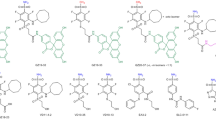Summary
The experiments reported in this paper were undertaken to explore the interaction of tritiated H2DIDS (4,4′-diisothiocyano-1,2,diphenyl ethane-2,2′-disulfonic acid) with Ehrlich ascites tumor cells. Addition of (3H)H2DIDS to tumor cell suspension at 21°C, pH 7.3, resulted in: (i) rapid reversible binding which increased with time and (ii) inhibition of sulfate transport. Tightly bound H2DIDS, i.e., reagent not removed by cell washing, also increased with time. Binding of 0.02 nmol H2DIDS/mg dry mass or less did not affect sulfate transport, but, at greater than 0.02 nmol and up to 0.15 nmol the relationship between tight binding and inhibition of transport is linear. The fact that H2DIDS could bind to the cell and yet not affect anion transport suggests that binding sites exist unrelated to those concerned with the regulation of anion permeability. Support for this is the observation that H2DIDS is spontaneously released from cells even after extensive washings by a temperature-sensitive process. The most important source of released H2DIDS is the cell surface coat which labels rapidly (within 1 min) and is then spontaneously released into the medium. A second source is derived from H2DIDS that slowly entered the cells. Consequently, at least four modes of interaction exist between H2DIDS and ascites tumor cells. These include both reversible and irreversible binding to membrane components which regulate anion permeability, irreversible binding to cell surface proteins or glycocalyx, and finally incorporation of H2DIDS into the intracellular phase.
Similar content being viewed by others
References
Benjaminson, M.A., Katz, I.J. 1970. Properties of SITS (4-acetamido-4′-isothiocyano stilbene-2,2′-disulfonic acid): Fluorescence and biological staining.Stain Technol 45:57
Cabantchik, Z.I., Rothstein, A. 1972. The nature of the membrane sites controlling anion permeability of human red blood cells as determined by studies with disulfonic stilbene derivates.J. Membrane Biol. 10:311
Cabantchik, Z.I., Rothstein, A. 1974a. Membrane proteins related to anion permeability of human red blood cells. I. Localization of disulfonic stilbene binding sites in proteins involved in permeation.J. Membrane Biol. 15:207
Cabantchik, Z.I., Rothstein, A. 1974b. Membrane proteins related to anion permeability of human red blood cells. II. Effects of proteolytic enzymes on disulfonic stilbene sites of surface proteins.J. Membrane Biol. 15:227
Cabantchik, Z.I., Rothstein, A. 1975. A comparison of intact human red blood cells and resealed and leaky ghosts with respect to their interaction with surface labeling agents and proteolytic enzymes.Biochim. Biophys. Acta 382:621
Ehrenspeck, G., Brodsky, W.A. 1976. Effect of 4-acetamido-4′-isothiocyano-2,2′-disulfonic stilbene on ion transport in turtle bladders.Biochim. Biophys. Acta 419:555
Fairbanks, G., Steck, T.L., Wallach, D.F.H. 1971. Electrophoretic analysis of the major polypeptides of the erythrocyte membrane.Biochemistry 10:2606
Hartree, E.A. 1972. Determination of protein: A modification of the Lowry method that gives a linear photometric response. Anal. Biochem48:422
Hong, S.K., Goldinger, J.M., Song, Y.K., Koschler, F.J., Lee, S.H. 1978. Effect of SITS on organic anion transport in rabbit kidney cortical slice.Am. J. Physiol. 3:F302
Jacquez, J.A. 1973. Sodium dependence of maximim flux,J m andK m of amino acid transport in Ehrlich ascites cells.Biochim. Biophys. Acta 318:411
Jacquez, J.A., Sherman, J.H., Terris, J. 1970. Temperature dependence of amino acid transport in Ehrlich ascites cells: With results which bear on theA-L distinction.Biochim. Biophys. Acta 203:150
Juliano, R.L., Behar-Bannelier, M. 1975. An evaluation of techniques for labeling the surface proteins of cultured mammalian cells.Biochim. Biophys. Acta 375:249.
Kilarski, W. 1975. Some ultrastructural features of the cell surface after SV40 transformation and somatic hybridization with normal untransformed cells.Cancer Res. 35:2797
Kim, W., Baumler, A., Carruthers, C., Bielat, K. 1975. Immunological escape mechanism in spontaneously metastasizing mammary tumors.Proc. Nat. Acad. Sci. USA 72:1012
Knauf, P.A., Rothstein, A. 1971. Chemical modification of membranes. I. Effects of sulfhydryl and amino reactive reagents on anion and cation permeability of the human red blood cell.J. Gen. Physiol. 58:190
Lepke, S., Fasold, F., Pring, M., Passow, H. 1976. A study of the relationship between inhibition of anion exchange and binding to the red blood cell membrane of 4,4′-diisothiocyano stilbene-2,2′-disulfonic acid (DIDS) and its dihydro-derivative (H2DIDS).J. Membrane Biol. 29:147
Levinson, C. 1978. Chloride and sulfate transport in Ehrlich ascites tumor cells: Evidence for a common mechanism.J. Cell. Physiol. 95:23
Levinson, C., Villereal, M.L. 1975. The transport of sulfate ions across the membrane of the Ehrlich ascites tumor cell.J. Cell. Physiol. 85:1
Maddy, H. 1964. A fluorescent label for the outer components of the erythrocyte membrane.Biochim. Biophys. Acta 88:390
Marinetti, G.V., Gray, G.M. 1967. A fluorescent chemical marker for the liver cell plasma membrane.Biochim. Biophys. Acta 135:580
Passow, H. 1977. Anion transport across the red blood cell membrane and the protein in band 3.Acta Biol. Med. Ger. 36:817
Rittenhouse, H.G., Rittenhouse, J.W., Takemoto, L. 1978. Characterization of the cell coast of Ehrlich ascites tumor cells.Biochemistry 17:829
Rothstein, A., Cabantchik, Z.I., Knauf, P. 1976. Mechanism of anion transport in red blood cells: Role of membrane proteins.Fed. Proc. 35:3
Russell, J.M., Boron, W.F. 1976. Role of chloride transport in regulation of intracellular pH.Nature (London) 264:73
Ship, S., Shami, Y., Breuer, W., Rothstein, A. 1977. Synthesis of tritiated 4,4′-diisothiocyano-2,2′-stilbene-disulfonic acid ([3H]DIDS) and its covalent reaction with sites related to anion transport in human red blood cells.J. Membrane Biol. 33:311
Stuhlmiller, G.M., Siegler, H.F. 1977. Enzymatic susceptibility and spontaneous release of human melanoma tumor-associated antigens.J. Nat. Cancer Inst. 58:215
Thomas, R.C. 1976. Ionic mechanism of the H+ pump in a snail neuron.Nature (London) 262:54
Villereal, M.L., Levinson, C. 1976. Inhibition of sulfate transport in Ehrlich ascites tumor cells by 4-acetamido-4′-isothiocyano-stilbene-2,2′-disulfonic acid (SITS).J. Cell. Physiol. 89:303
Zaki, L., Fasold, B., Schuhmann, B., Passow, H. 1975. Chemical modification of membrane proteins in relation to inhibition of anion exchange in human red blood cells.J. Cell. Physiol. 86:471
Author information
Authors and Affiliations
Rights and permissions
About this article
Cite this article
Levinson, C., Corcoran, R.J. & Edwards, E.H. Interaction of tritium-labeled H2DIDS (4,4′-diisothiocyano-1,2,diphenyl ethane-2,2′disulfonic acid) with the ehrlich mouse ascites tumor cell. J. Membrain Biol. 45, 61–79 (1979). https://doi.org/10.1007/BF01869295
Received:
Revised:
Issue Date:
DOI: https://doi.org/10.1007/BF01869295



